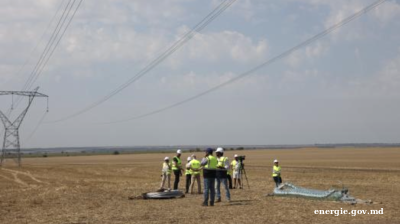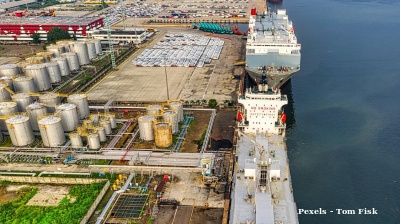Ukraine’s strikes on Russian oil refineries are doing what oil sanctions have failed to achieve: reducing the Kremlin’s income from oil production, limiting its supply of fuel for the army and pushing up domestic prices, but without affecting the international markets for oil. Despite US fears, the effect of the attacks will be to drive international oil prices down, not up.
Since the drone war started earlier this year, new long-distance drones have struck at least 20 targets deep in Russian territory, causing fires and threatening to put refineries out of action for weeks as increasingly difficult to effect repairs are carried out.
The attacks do not destroy refineries. Thanks to the legacy of the Cold War, most refineries were built to withstand attack and have air defences, as bne IntelliNews reported in an article looking at how much damage Ukraine’s drone attacks on oil refineries can do.
Nevertheless, Russia’s oil products production has fallen by an estimated 14% between January and March as a result, causing shortages for the civilian population, if not for industry and the military; Russia has significant over-production capacity to enable exports and only an estimated 40% of its refineries are in range. But the attacks have already caused the domestic prices for oil and diesel to surge.
The attacks have compelled Moscow to implement a six-month ban on gasoline exports and import gasoline from Belarus as well as asking Kazakhstan to create a reserve of 100,000 barrels in case of emergencies. One of the world's largest oil producers has been forced to slash its refining capacity, which is damaging the economy it relies on to fund the ongoing war in Ukraine.
Ukrainian strikes have achieved what Western sanctions have not: a reduction in Russia's ability to convert crude oil into the fuels needed to power its military.
But the strategy has made the US very nervous, with Secretary of Defence Lloyd Austin expressing concerns that these strikes might "have a knock-on effect in terms of the global energy situation" by pushing up global oil prices. That hasn’t happened.
Ukraine insists that targeting Russia's refineries will instead drive down international oil prices. By limiting Russia's refining capabilities, Ukraine effectively forces Moscow to export more crude oil, increasing supply and driving prices down.
“Russia is exporting more crude, while its refined exports have hit near-historic lows,” Tymofiy Mylovanov, rector of the Kyiv School of Economics (KSE) and former economics minister, said in a tweet.
“Moscow exported just over 712,000 tonnes of diesel and other petroleum products in the last week of April, a drop from more than 844,000 tonnes in the same week in 2023,” Mylovanov added. Monthly exports of crude oil, however, rose by 9% from February to March, reaching their highest level in nine months and their third highest since Western sanctions on Russian crude oil took effect in December 2022.
To drive the point home, a Ukrainian drone hit a Gazprom oil refinery in Salavat (Salavatnefteorgsintez) in Russia’s republic of Bashkortostan 1,500 km from the Ukrainian border, the first time the region has been struck since the war started.
“This Gazprom refinery is one of Russia's largest oil refining and petrochemical production complexes. It specialises in the production of gasoline, diesel fuel and other types of petroleum products. In 2022, the Salavat refinery processed 6.7mn tonnes of oil,” Mylovanov said.
In 2023, Russia produced approximately 10.1mn barrels per day (bpd) of oil – about the same level as pre-war – half of which was refined domestically to produce fuel products, including gasoline and diesel, consumed by the military and the domestic market. The remaining 50% was exported as crude oil to refineries abroad. Although Russia continues to export fuel products to Turkey, China and Brazil, most Western nations have ceased importing Russian refined fuels. The Ukrainian strikes have knocked out up to 900,000 bpd of Russian refining capacity, leading to repair delays due to complex equipment and Western sanctions preventing access to specialised components.
With limited oil storage capacity, Russia faces a tough choice: either increase crude oil exports at lower prices or shut wells. Should Russia halt production, global oil prices would rise, driving up Russia’s own costs for fuel, but reducing the oil export revenues it needs to cushion the blow.
And Russia is already ramping up crude oil exports as the production of refined products fall, with monthly shipments rising by 9% between February and March, reaching a nine-month high. Conversely, the country's refined fuel exports have plummeted. The Ukrainian strategy is working and is inflicting palpable pain on Russia’s oil business. Diesel production has fallen by 16%, and gasoline production by 9% since Ukraine began targeting Russian refineries.
Wholesale fuel prices in Russia have surged due to the reduced refining capacity. Gasoline prices rose by 23%, and diesel prices jumped by 47% in western Russia between the end of 2023 and mid-March, according to KSE. Gasoline hit a six-month high in April, rising over 20% from January, forcing the Kremlin to ask for help from its friends in Belarus and Kazakhstan.
Russian consumers have so far been shielded from the wholesale price hikes, but retail diesel prices surged by 10% in the last week of April. This indicates that oil companies might be absorbing the price increases, reducing their margins, or that the Kremlin has expanded fuel subsidies.
Despite its success, the strikes on oil refineries is not going stop the war anytime soon; crude oil exports may be increasing their share in exports, but the current high oil prices, supported by the OPEC+ voluntary production cuts, have led to a surge in income for Russia’s budget.
Russian oil export revenues surged to $17.2bn in March 2024, driven by higher global oil prices and increased crude export volumes, according to the April ‘Russian Oil Tracker’ by KSE Institute. Despite robust US Treasury sanctions targeting the shadow fleet, Russia continues to expand it by incorporating new tankers, allowing for stable exports and further evasion of oil price cap. Russian seaborne oil exports rose by 4% in March, driven by a 12% increase in crude oil shipments (+400,000 bpd), while exports of oil products declined by 6%.
However, the one place where the strain on the system is already showing up is that the discount that Russia has to offer customers is rising again and reached $18 at the end of last year, according to KSE, from a low of $13.7 dollars in October. Previously, analysts were predicting that the discount could fall to as low as $10 this year, due to the success of redirecting all of Russia’s oil exports from Europe to Asia.
In the end, Ukraine's strikes have weakened Russia's refining capacity without significantly affecting global oil prices, reducing the Kremlin's income and increasing domestic fuel costs, all while forcing Russia to rely more on crude oil exports to sustain its economy.

Russian oil export volume by type and destination

Russian oil export revenues in USD and RUB

Discount on Russian oil to Brent
|
Major infrastructure drone attacks YTD |
|
|
Asset |
date |
|
Kremenchuk oil refinery Ukraine |
first weeks of war |
|
Gazpromtrans railway in Nizhny Tagil in the Sverdlovsk region |
January 8 |
|
Oryolnefteprodukt in Oryol region |
January 9 |
|
St Petersburg Oil Terminal |
January 18 |
|
Klintsy oil depot in the Bryansk region |
January 19 |
|
Yaroslavl refinery in the Yaroslavl region |
January 19 |
|
Ust-Luga near St Petersburg |
January 21 |
|
Tuapse oil refinery in the Krasnodar region |
January 25 |
|
Volgogradneftepererabotka in the Volgograd region |
February 3 |
|
Ilsky and Afipsky refineries in the Krasnodar region |
February 9 |
|
Polyova oil depot in the Kursk region |
February 14 |
|
NLMK steel works in Lipetsk Oblast |
February 24 |
|
NORSI refinery in the Nizhny Novgorod region |
March 12 |
|
Ryazan refinery in the Ryazan region |
March 13 |
|
Rostov refinery in Rostov on Don |
March 13 |
|
Nizhny Novgorod refinery in Nizhny Novgorod region |
March 13 |
|
Syzran oil refinery |
March 15 |
|
Slavyansk refinery, Nefte Peregonnyy Zavod in Slavyansk-on-Kuban in the Krasnodar Krai |
March 17 |
|
Domodedova airport in Moscow |
March 17 |
|
Novokuybyshevsk refinery in the Samara region |
March 21 |
|
Kuybyshev NPZ refinery in the Samara region |
March 21 |
|
Zaporizhzhia Dnipro Hydroelectric Power Plant in Ukaine |
March 21 |
|
Thermal power plants in Kharkiv in Kharkiv Oblast in Ukraine |
March 22 |
|
Kirishi refinery in the Leningrad Oblast |
March 22 |
|
Kuibyshev oil refinery in the Samara region |
March 23 |
|
President's Office denies statements that US asked to stop attacks on Russian refineries |
March 22 |
|
Dnipro Hydroelectric Power Plant in the Zaporizhzhia, Ukrine |
March 22 |
|
Rostov power plans in the Rostov Oblast |
March 25 |
|
Nizhnekamsk refinery in Tatarstan |
April 2 |
|
Taneco refinery in the Tatarstan region |
April 2 |
|
Trypilska Thermal Power Plant in Kyiv Ukraine |
April 11 |
|
Kardym district oil depo in the Smolensk region |
April 20 |
|
Razdorovo oil depo in Yartsevo in the Smolensk region |
April 24 |
|
Naftovyki industrial zone in Omsk region |
April 25 |
|
Krasnodar Krai oil refinery in Slavyansk-on-Kuban and Ilsky oil refineriey |
April 27 |
|
Ryaza refinery in Ryzan region |
May 1 |
|
Luhansk oil depot |
May 7 |
|
Russian strikes energy assets in six regons |
May 8 |
|
Bashkir refinery |
May 9 |
|
source: reports, bne IntelliNews |
|
Features

World GDP forecasts raised, but US slowdown anticipated - Fitch
Global growth is now forecast to be 2.4% in 2025, up 0.2pp since June but a sizeable slowdown from 2.9% last year and below trend.

Moldova’s dramatic energy sector transformation
Chisinau ended decades of dependence on Russia in just four years — but will the upcoming general election derail the remaining reforms?

Local elections loom in Georgia
Georgia’s October 4 municipal elections are already mired in controversy amid a partial opposition boycott and mounting state repression, as major international observers refuse to participate.

Iran's nuclear materials 'Under rubble of attacks', Foreign Minister claims
Iran's Araghchi says that the only nuclear site currently accessible is the Russian-controlled Bushehr nuclear power plant in his meeting with the IAEA.



